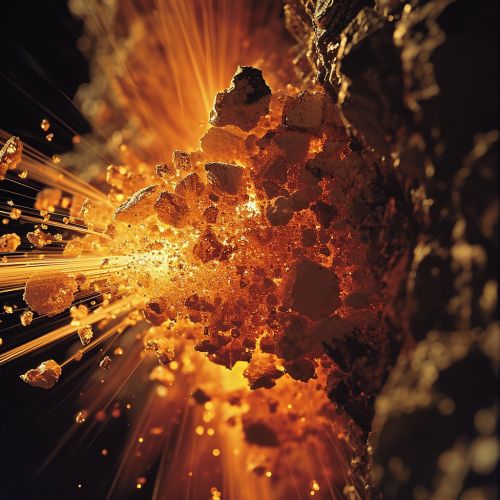Gamma Radiation
Introduction
Gamma radiation, also known as gamma rays, is a form of electromagnetic radiation that is characterized by its high energy and short wavelength. It is the most penetrating and energetic form of electromagnetic radiation, capable of damaging living tissue and causing serious health effects. Gamma radiation is produced by certain types of radioactive decay, high-energy particle interactions, and high-energy phenomena in space.
Production of Gamma Radiation
Gamma radiation is produced in several ways. The most common source of gamma radiation is the decay of radioactive isotopes, a process known as gamma decay. Gamma decay occurs when an unstable nucleus emits a gamma ray to reach a more stable state. This process is often accompanied by the emission of other particles, such as alpha or beta particles.


Another source of gamma radiation is the interaction of high-energy particles. When a high-energy particle, such as a cosmic ray, strikes a nucleus, it can cause the nucleus to become excited and emit a gamma ray. This process is known as pair production.
Gamma radiation is also produced by high-energy phenomena in space, such as supernovae, pulsars, and black holes. These events produce gamma rays as part of their energy output, contributing to the gamma-ray background that permeates the universe.
Properties of Gamma Radiation
Gamma rays are characterized by their high energy and short wavelength. The energy of a gamma ray is typically measured in electron volts (eV), with energies ranging from a few thousand eV to several billion eV. The wavelength of a gamma ray is typically on the order of picometers (10^-12 meters), much shorter than the wavelength of visible light.
Due to their high energy and short wavelength, gamma rays are extremely penetrating. They can pass through many materials that other forms of radiation cannot, including human tissue. This makes gamma radiation a significant health hazard, as it can damage cells and DNA, leading to cancer and other health effects.
Gamma rays are also ionizing radiation, meaning they have enough energy to ionize atoms and molecules, knocking off electrons and creating ions. This ionizing property is what makes gamma radiation so damaging to living tissue.
Detection and Measurement of Gamma Radiation
Detecting and measuring gamma radiation is a critical part of radiation safety and nuclear physics. There are several types of detectors used to measure gamma radiation, including Geiger-Muller counters, scintillation detectors, and semiconductor detectors.


A Geiger-Muller counter is a simple and widely used device for detecting gamma radiation. It consists of a gas-filled tube and an electrode. When gamma radiation enters the tube, it ionizes the gas, creating a current that can be measured.
Scintillation detectors work by using a scintillating material that emits light when struck by gamma radiation. This light is then detected and measured.
Semiconductor detectors use a semiconductor material, such as silicon or germanium, that produces a current when struck by gamma radiation. These detectors are more sensitive and accurate than Geiger-Muller counters or scintillation detectors, but they are also more expensive.
Uses of Gamma Radiation
Despite its dangers, gamma radiation has many important uses. In medicine, gamma rays are used in radiation therapy to treat cancer. The high energy and penetrating power of gamma rays make them ideal for killing cancer cells. Gamma rays are also used in medical imaging, such as in single photon emission computed tomography (SPECT) and positron emission tomography (PET) scans.
In industry, gamma rays are used in a variety of applications. They are used in radiography to inspect materials and structures for defects. They are also used in sterilization, to kill bacteria and other microorganisms on medical equipment and other products.
In science, gamma rays are used in a variety of research applications. They are used in nuclear physics to study the properties of atomic nuclei. They are also used in astrophysics to study high-energy phenomena in the universe.
Hazards of Gamma Radiation
While gamma radiation has many uses, it is also a significant health hazard. Exposure to gamma radiation can cause a variety of health effects, ranging from mild symptoms such as nausea and vomiting, to serious conditions such as cancer and radiation sickness.
The health effects of gamma radiation are due to its ionizing property. When gamma rays pass through living tissue, they can ionize atoms and molecules, damaging cells and DNA. This can lead to mutations and cancer.
In addition to its health effects, gamma radiation can also pose a safety hazard. Due to its penetrating power, gamma radiation can pass through many materials, making shielding difficult. Special materials and designs are required to effectively shield against gamma radiation.
Conclusion
Gamma radiation is a fascinating and complex phenomenon. It is a form of electromagnetic radiation that is produced by radioactive decay, high-energy particle interactions, and high-energy phenomena in space. Despite its dangers, gamma radiation has many important uses in medicine, industry, and science. However, due to its health and safety hazards, careful measures must be taken to protect against exposure to gamma radiation.
